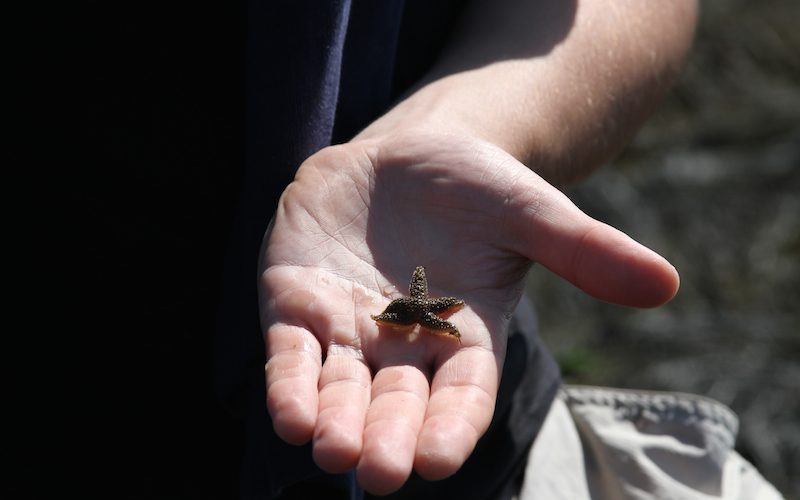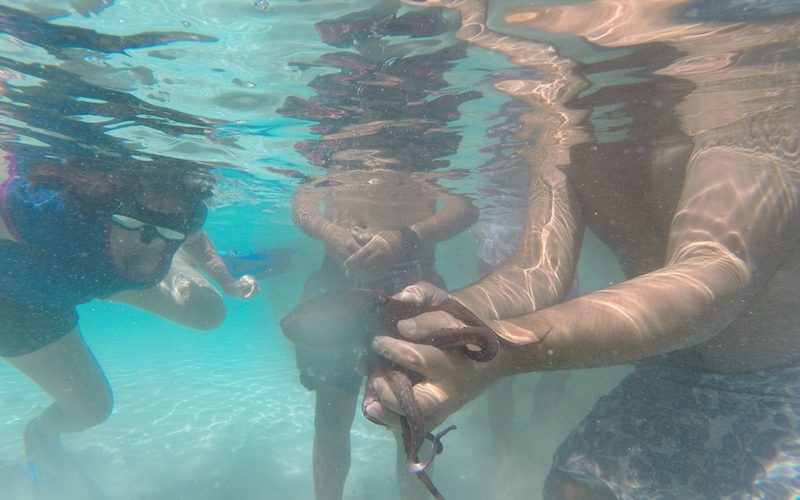Marine Science Students Research Ocean Changes, Microplastics, Invasive Species, and More
By Rebecca Goldfine





At the conclusion of the fall semester, it is a tradition for the Bowdoin Marine Science Semester students to present their independent research projects at the Schiller Coastal Studies Center. To a gathered group of scientists and students, they explain how they designed their experiments and what they discovered. The ten participants in the program this year pursued a range of inquiries, from how climate change might be changing snails’ eating habits to how much microplastic is being eaten by zooplankton.
The Marine Science Semester is an immersive academic program focusing on the study of benthic ecology, biological oceanography, coastal Maine history, and marine molecular ecology and evolution. While much of their time is spent at the Schiller Coastal Studies Center in Harpswell, students also take several field trips to Gulf of Maine islands and to Baja California. Of the semester’s four class modules, three are science courses and one is a humanities class, and students complete an in-depth research project.
Below are brief overviews of three student projects:
Clayton Starr ’19, The rise of a Super Snail: The effects of temperature and acidity on Nucella lapillus feeding rates
The Nucella lapillus, or the common dog whelk, is an important intertidal species because it preys on barnacles and mussels. In this way, it affects the population size and distribution of these species. Dog whelks tend to eat more and to eat more efficiently when water temperatures are warmer in the summer. So Starr was curious to find out whether changing ocean conditions, caused by climate change, would affect dog whelk feeding habits. He set up an experiment to see whether ocean acidity and/or warmer ocean waters will change how much and how quickly the snails eat. He found that while the dog whelks in his higher-temperature tanks did eat more and began eating more quickly than the ones in colder tanks, they did not appear to be affected by water acidity. “In 20, 30, 40 years, snail predation on blue mussels will likely increase,” Starr said.
Caroline Godfrey ’19, Munching on Microplastics: Consumption Rate of Polystyrene Microplastics in the Intertidal Copepod Tigriopus californicus
By studying what tiny copepods eat, Godfrey in her research looked at a small but significant piece of the monumental problem of plastic pollution in the ocean. In 2012, global plastic production reached 288 million metric tons, a 620 percent increase since 1975. Much of this plastic was generated in coastal regions, where it can migrate into the ocean and harm marine animals and contaminate the food chain. It’s also not just large creatures eating the plastics, like sea turtles, but smaller animals such as zooplankton. Zooplankton, which include copepods, drift in the seas and eat phytoplankton (and, apparently, what resembles phytoplankton — plastic broken down into micro-particles). Godfrey tested whether the intertidal copepod Tigriopus californicus can distinguish between isochrysis (a common phytoplankton) and plastic micro-beads, and whether it has a preference. She found that while copepods do eat a substantial amount of microplastic, they prefer isohcrysis, even when it’s been mixed with plastic, consuming roughly twice as much of the natural substance as the synthetic stuff.
Hugh Cipparone ’19, Wild Crabs of the North: Optimal prey selection and distinct populations of the European Green Crab
The green crab, an aggressive newcomer to the Gulf of Maine from Europe, has arrived in our waters in two waves, the first in the 1800s and one more recently. As a result, there are two genetically distinct lineages of the crab: one of these lives in colder, more northern waters, while the other thrives in warmer waters. Cipparone tested to see whether these two populations are equally aggressive, and whether that affects the size of prey they target. “Green crabs affect eelgrass beds and soft shell clams, so knowledge of their feeding preferences and behaviors is important,” Cipparone said. Before conducting his experiment, he hypothesized that the northern crabs, which have a reputation for being vicious, would pursue bigger mussels. What he found is that when they have a choice, northern crabs strongly avoid smaller mussels, instead targeting medium to large mussels. And while southern crabs also preferred medium to large mussels, they didn’t avoid small mussels as much.
- David Anderson ’19, A battle of the wits: Comparing the learning ability of the invasive crab Carcinus maenas to the native crab Cancer inornatus in the Gulf of Maine
- Zakir Bulmer ’19, Stressed-out Lobsters: Thermal Stress, Microbes, and the American Lobster, Homarus americanus
- Patrick Warner ’20, Getting Fishy: Fish Populations in Harpswell Sound
- Charlotte Nash ’19, Phragmites australis Invasion Impacts on Zonation and Carbon Sequestration of a Restored Brackish Tidal Marsh
- Jesse Dunn ’20, Living with this mess: symbiosis in aquaculture to cope with ocean acidification
- Claire Goffinet ’19, Plastic accumulation within stomach content of Fundulus heteroclitus in Maine coastal waters
- Miranda Miller ’19, The Effects of Maine Autumn and Extreme Summer Temperatures on Macroalgal Photosynthesis and Water Chemistry



